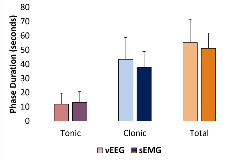Automated Calculation of Tonic and Clonic Phase Lengths in GTC Seizures From Single-Channel EMG
Abstract number :
3.085
Submission category :
2. Translational Research / 2B. Devices, Technologies, Stem Cells
Year :
2018
Submission ID :
502633
Source :
www.aesnet.org
Presentation date :
12/3/2018 1:55:12 PM
Published date :
Nov 5, 2018, 18:00 PM
Authors :
Damon Cardenas, Brain Sentinel, Inc.; Jonathan Halford, Medical University of South Carolina; Shannon Voyles, Brain Sentinel, Inc.; Luke Whitmire, Brain Sentinel, Inc.; and José Cavazos, Brain Sentinel, Inc.
Rationale: Generalized Tonic-Clonic Seizures (GTCS) are the most common seizure type associated with sudden death in epilepsy (SUDEP).[1] The frequency and characteristics of GTCS may help predict the risk of SUDEP and aid in epilepsy syndrome classification.[2] This study investigates whether an automated system can define the length of the phases of a GTCS using long-term surface electromyography (sEMG). Methods: Twenty-four GTCS from 21 patients from 6 different level 4 epilepsy monitoring units (EMUs) were simultaneously recorded with video-EEG ( vEEG) and sEMG .[3] The vEEG recordings were reviewed by three independent ABPN certified epileptologists to document tonic duration, clonic duration, and total duration of each GTCS.The sEMG recordings (sampled at 1 kHz by the SPEAC System) from 24 seizures were parsed into 2-minute segments. The tonic, clonic, and total motor phases of the GTCS were detected based on frequency and amplitude characteristics (in Matlab, Mathworks). The frequency components were computed using the continuous wavelet transform as previously described[4]and amplitude values were empirically derived. Results: The average duration (in seconds) for the tonic, clonic, and total motor phases of the GTCS, as determined by the reviewers were: 11.9 s ± 5.3, 43.4 s ± 15.4, and 55.1 s ± 16.0 respectively (µ ± s). The average time for each phase as determined by the sEMG monitor were: 13.2s ± 7.4, 38.0s ± 10.7, 51.1s ± 10.6 respectively. Using paired t-test with Bonferroni correction, the tonic, clonic, and total durations were not significantly different between the expert review and the automated system (p < .05, Figure). The average difference in seconds between the two methods with 95% confidence limits are: 1.25s [-1.46; 3.97], -5.42s [-9.34; -1.51], -4.04s [-8.91; 0.83]. Conclusions: With sEMG data collected by the SPEAC System, automated calculation of tonic and clonic motor activity are similar to what is observed by epileptologists reviewing vEEG recorded in the EMU. Since the SPEAC System® is designed to record continuous sEMG data for months at a time, automated quantification of the lengths of tonic and clonic phases of GTCS may provide more information to physicians who are interpreting long-term EMG recordings of patients who have GTCS. This information may provide details to help stratify a patient’s risk for PGES, need for SUDEP education, and guide the overall treatment plan.References.1. Tomson T, et al. Sudden unexpected death in Epilepsy: a review of incidence and risk factors. Epilepsia. 2005;46:54-61.2. Tao JX, et al. Tonic phase of a generalized convulsive seizure is an independent predictor of postictal generalized EEG suppression. Epilepsia. 2013;54(5):858-865.3. Halford JJ, et al. Detection of generalized tonic-clonic seizures using surface electromyographic monitoring. Epilepsia. 2017;58(11):1861-1869.4. Cardenas DP, et al. Using surface electromyography to differentiate between generalized tonic-clonic seizures and psychogenic non-epileptic seizures. 2017: AES 2017. Funding: Funding provided by Brain Sentinel®.
